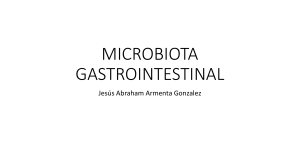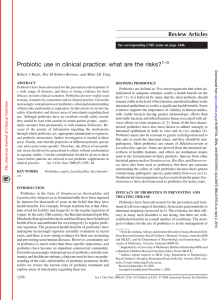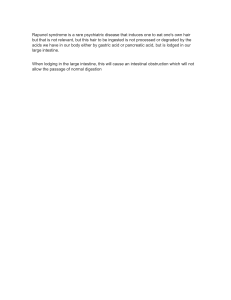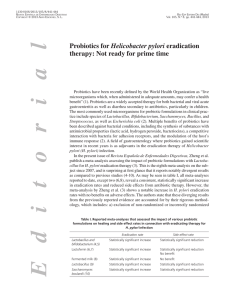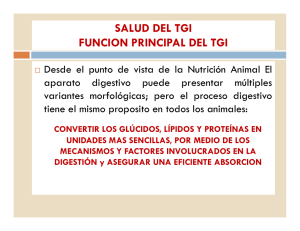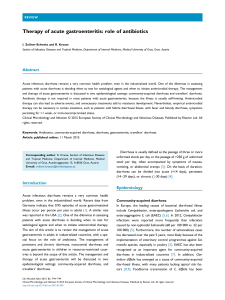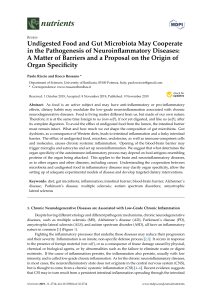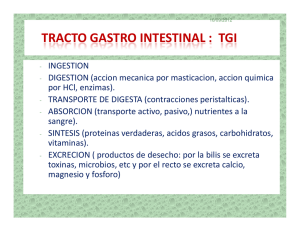1. Saccharomyces boulardii CNCM I-745 A Non-bacterial Microorganism Used as Probiotic Agent in Supporting Treatment of Selected Diseases
Anuncio
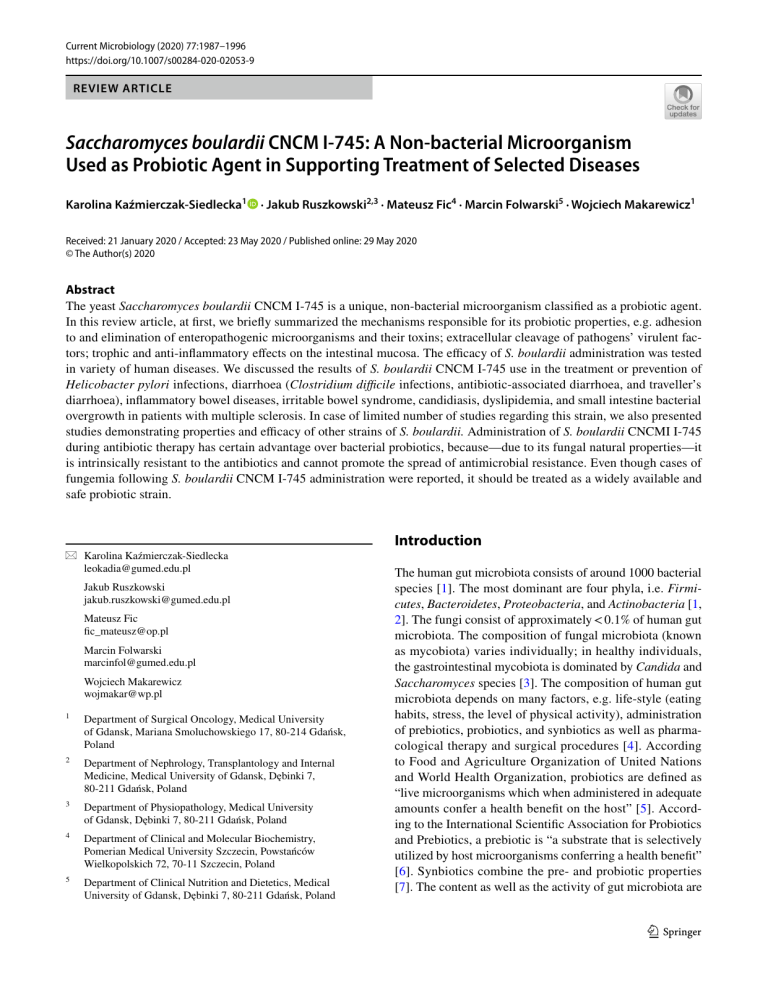
Current Microbiology (2020) 77:1987–1996 https://doi.org/10.1007/s00284-020-02053-9 REVIEW ARTICLE Saccharomyces boulardii CNCM I‑745: A Non‑bacterial Microorganism Used as Probiotic Agent in Supporting Treatment of Selected Diseases Karolina Kaźmierczak‑Siedlecka1 · Jakub Ruszkowski2,3 · Mateusz Fic4 · Marcin Folwarski5 · Wojciech Makarewicz1 Received: 21 January 2020 / Accepted: 23 May 2020 / Published online: 29 May 2020 © The Author(s) 2020 Abstract The yeast Saccharomyces boulardii CNCM I-745 is a unique, non-bacterial microorganism classified as a probiotic agent. In this review article, at first, we briefly summarized the mechanisms responsible for its probiotic properties, e.g. adhesion to and elimination of enteropathogenic microorganisms and their toxins; extracellular cleavage of pathogens’ virulent factors; trophic and anti-inflammatory effects on the intestinal mucosa. The efficacy of S. boulardii administration was tested in variety of human diseases. We discussed the results of S. boulardii CNCM I-745 use in the treatment or prevention of Helicobacter pylori infections, diarrhoea (Clostridium difficile infections, antibiotic-associated diarrhoea, and traveller’s diarrhoea), inflammatory bowel diseases, irritable bowel syndrome, candidiasis, dyslipidemia, and small intestine bacterial overgrowth in patients with multiple sclerosis. In case of limited number of studies regarding this strain, we also presented studies demonstrating properties and efficacy of other strains of S. boulardii. Administration of S. boulardii CNCMI I-745 during antibiotic therapy has certain advantage over bacterial probiotics, because—due to its fungal natural properties—it is intrinsically resistant to the antibiotics and cannot promote the spread of antimicrobial resistance. Even though cases of fungemia following S. boulardii CNCM I-745 administration were reported, it should be treated as a widely available and safe probiotic strain. * Karolina Kaźmierczak‑Siedlecka [email protected] Jakub Ruszkowski [email protected] Mateusz Fic [email protected] Marcin Folwarski [email protected] Wojciech Makarewicz [email protected] 1 Department of Surgical Oncology, Medical University of Gdansk, Mariana Smoluchowskiego 17, 80‑214 Gdańsk, Poland 2 Department of Nephrology, Transplantology and Internal Medicine, Medical University of Gdansk, Dębinki 7, 80‑211 Gdańsk, Poland 3 Department of Physiopathology, Medical University of Gdansk, Dębinki 7, 80‑211 Gdańsk, Poland 4 Department of Clinical and Molecular Biochemistry, Pomerian Medical University Szczecin, Powstańców Wielkopolskich 72, 70‑11 Szczecin, Poland 5 Department of Clinical Nutrition and Dietetics, Medical University of Gdansk, Dębinki 7, 80‑211 Gdańsk, Poland Introduction The human gut microbiota consists of around 1000 bacterial species [1]. The most dominant are four phyla, i.e. Firmicutes, Bacteroidetes, Proteobacteria, and Actinobacteria [1, 2]. The fungi consist of approximately < 0.1% of human gut microbiota. The composition of fungal microbiota (known as mycobiota) varies individually; in healthy individuals, the gastrointestinal mycobiota is dominated by Candida and Saccharomyces species [3]. The composition of human gut microbiota depends on many factors, e.g. life-style (eating habits, stress, the level of physical activity), administration of prebiotics, probiotics, and synbiotics as well as pharmacological therapy and surgical procedures [4]. According to Food and Agriculture Organization of United Nations and World Health Organization, probiotics are defined as “live microorganisms which when administered in adequate amounts confer a health benefit on the host” [5]. According to the International Scientific Association for Probiotics and Prebiotics, a prebiotic is “a substrate that is selectively utilized by host microorganisms conferring a health benefit” [6]. Synbiotics combine the pre- and probiotic properties [7]. The content as well as the activity of gut microbiota are 13 Vol.:(0123456789) 1988 important issues. The changes in gut microbiota may lead to gut dysbiosis (qualitative and quantitative alterations) [1, 2]. Infectious agents, intake of drugs (antibiotics or anti-cancer treatment) as well as inflammatory diseases are selected factors contributing to gut dysbiosis [2, 8]. Therapeutic methods, which are used to modify gut microbiota are administration of prebiotics (e.g. lactulose, fructooligosaccharides), probiotics (e.g. Lactobacillus plantarum, Bifidobacterium), synbiotics, and faecal microbiota transplantation [9, 10]. The yeast—Saccharomyces boulardii (S. boulardii) CNCM I-745 is a non-bacterial microorganism classified as a probiotic agent. It should be emphasized that S. boulardii CNCM I-745 is the first yeast that has been studied for use as a probiotic strain in human medicine [11]. There are available studies confirming positive effects of administration of S. boulardii CNCM I-745 in supporting treatment of selected diseases. This review summarizes the current knowledge about the role of S. boulardii in treatment of Helicobacter pylori infections, diarrhoea (Clostridium difficile infections, antibiotic-associated diarrhoea, and traveller’s diarrhoea), inflammatory bowel diseases (IBD), irritable bowel syndrome (IBS), candidiasis, dyslipidemia as well as gastrointestinal symptoms associating with small intestine bacterial overgrowth (SIBO) in multiple sclerosis (MS) patients. Most of the studies found in the literature were performed with CNCM I-745 strain, however, due to the lack of publications for some therapeutic area we also discussed other strains of S. boulardii. Properties of S. boulardii CNCM I‑745 Saccharomyces boulardii CNCM I-745 was discovered by Henri Boulard (French microbiologist) in 1920 [11]. The probiotic strain of S. boulardii CNCM I-745 belongs to Saccharomyces cerevisiae species. Originally, S. boulardii was isolated from peels of tropical fruit. It is stable over a wide range of pH including acidic condition and temperature levels also during exposure to bile salts and gastrointestinal enzymes [12]. It is resistant to the antibiotic, because of fungal natural properties. Moreover, the administration of S. boulardii CNCM I-745 cannot promote antibiotic resistance because exchange of antibiotic resistance genes with bacteria is unlikely [13, 14]. In the most recent study, Moré et al. have summarized evidences that S. boulardii improves digestive capacity through secretion of certain enzymes (e.g. highly active sucrase), as well as through secretion of polyamines (spermine and spermidine) that increase the expression of both intestinal digestive enzymes and nutrient uptake transporters. The exact molecular mechanisms of the trophic effects of S. boulardii and secreted polyamines are not completely understood. They can activate at least the 13 K. Kaźmierczak‑Siedlecka et al. GRB2-SHC-CrkII-Ras-GAP-Raf-ERK1,2 pathway and the PI3K pathway, and decreased activation of p38 MAPK [15]. Saccharomyces boulardii CNCM I-745 shares more than 99% genomic relatedness with non-probiotic S. cerevisiae strains as measured by average nucleotide identity (ANI) [16]. However, there are some differentiating genetic features between S. boulardii and S. cerevisiae, such as specific microsatellite length polymorphisms of YLR177W and YKL139W genes [17, 18] and low relatedness in hybridization analysis with retrotransposon Ty917 probe [18]. Recently published comparative genomic analysis of Saccharomyces spp. has shown that all S. boulardii (including S. boulardii CNCM I-745) strains are distinctive from other S. cerevisiae due to the absence of two hexose transporters genes (HXT9 and HXT11) and two maltose-, three palatinose- and four asparagine-utilization genes (MAL11, MAL13; IMA2, IMA3, IMA4; ASP3-1, ASP3-2, ASP3-3, ASP4-4) [16]. Moreover, all sequenced S. boulardii strains (including CNCM I-745) possess G1278A point mutation in PGM2 gene that causes truncation of phosphoglucomutase; it impairs galactose utilization but in return confers growth advantages on glucose at a higher temperature (37 °C) [19]. Furthermore, S. boulardii strains, including CNCM I-745, produce higher amounts of acetic acid in 37 °C than S. cerevisiae strains [20]. The reduction in the pH of the gastrointestinal lumen is frequently described mechanism of probiotics, e.g. against Salmonella enterica serovar Typhimurium [21], against Vibrio cholerae [22] or against Blastocystis [23]. Using Escherichia coli MG1655 as an indicator strain, Offei et al. have showed that medium acidification via acetic acid results in antibacterial activity of S. boulardii, and have included unique high acetic acid production as an another probiotic properties of S. boulardii [20]. However, it requires in vivo confirmation. Interestingly, they have proved that this conspicuous difference in acetic acid production is a result of unique for S. boulardii strains single-nucleotide polymorphisms (SNPs) in SDH1 and WHI2 genes [20]. To sum up, the genetic differences between S. boulardii CNCM I-745 and S. cerevisiae might provide explanation of this probiotic potency. The action of S. boulardii CNCM I-745 is based on several mechanisms such as immunological and anti-toxin effects, pathogen-binding, as well as effects on digestive enzymes [11]. The interaction with enteropathogenic microogranisms and the effect on the intestinal mucosa are the main targets and potential mechanisms of S. boulardii ‘s CNCM I-745 action is presented in Fig. 1. As it was stated above, S. boulardii CNCM I-745 has a beneficial effect against infections caused by pathogenic bacteria (e.g. Clostridium difficile, Salmonella, Shigella, Escherichia coli), viruses (rotavirus), and even yeasts (mainly Candida albicans) [11]. Using rat and mouse models, it has been demonstrated that S. boulardii CNCM I-745 Saccharomyces boulardii CNCM I‑745: A Non‑bacterial Microorganism Used as Probiotic Agent… 1989 Fig. 1 The potential mechanisms of S. boulardii CNCM I-745 action. cAMP cyclic adenosine monophosphate. Own elaboration based on literature [11, 15] significantly increases the concentration of intestinal sIgA and can stimulate IgA-response to Clostridium difficile toxin A, respectively [24, 25]. It should be emphasized that sIgA release is the first-line of defense against pathogens in the intestine [26], thus, the stimulation of sIgA after administration of S. boulardii CNCM I-745 is desired and may be an important mechanism for S. boulardii-mediated protection against diarrhoeal illnesses. Moreover, Castagliuolo et al. have reported that S. boulardii inhibits Clostridium difficile toxin A enteritis in rats by releasing a 54-kDa protease which digests the toxin A molecule and diminishes toxin A and B binding to colonic brush border membrane receptor [27]. Both toxin A and B activate the pro-inflammatory pathways (the nuclear translocation of NF-κB and the activation by phosphorylation of MAP kinases, which induce the synthesis of cytokines). It should be emphasized that cultures supernatant of S. boulardii inhibit pro-inflammatory cytokine (IL-8) synthesis and nuclear translocation of NF-κB. As Chen et al. reported, S. boulardii reduces IL-8 production via inhibition of the activation of the MAP kinases Erk1/2 and JNK/SAPK [28]. The Effects of S. boulardii on Intestinal Microbiota The oral administration of S. boulardii CNCM I-745 has no effect on intestinal microbiota in healthy subjects, which was shown in several studies in humans as well as in mice. However, the alterations of the microbiota in some diseases with intestinal dysbiosis after treatment with S. boulardii CNCM I-745 are observed [14]. The administration of S. boulardii CNCM I-745 can restore the intestinal microbiota faster, which was shown in a model of amoxicillin-treated mice. It was noted that the antibiotic therapy causes the increasing abundance of Enterobacteriaceae and Bacteroides and at the same time it decreases the level of Clostridium coccoides and Eubacterium rectale. The therapy of S. boulardii CNCM I-745 accelerated the restoration of the normal microbiota in 10 days, while the same results were observed in 22 days in untreated mice [29, 30]. In the most recent review (included preclinical and clinical data), it was confirmed that treatment with S. boulardii CNCM I-745 in dysbiosis leads to the faster reestablishment of a healthy microbiota [14]. However, the administration of S. boulardii CNCM I-745 after antibiotic therapy accelerates the recovery of the intestinal microbiota to the initial level [14]. Similarly, Swidsinski et al. reported that a total of 88% of patients with bacterial vaginosis (treated with ciprofloxacin and metronidazole) receiving S. boulardii CNCM I-745 quickly restored their initial individual microbial profiles [31]. Moreover, as it was stated above, S. boulardii is a yeast, thus it is resistant to antibiotics, which is its additional value [14, 32]. Additionally, Kelly et al. have shown that S. boulardii CNCM I-745 prevents the disruption of the faecal bile acids metabolism during antimicrobial therapy in healthy volunteers [33]. Moré et al. summarized evidences that S. boulardii CNCM I-745 support the regeneration of the intestinal microbiota after diarrhoeic dysbiosis [14]. They emphasized that the most relevant effects of this yeast on the faecal 13 1990 microbiota composition are the increasing of short-chain fatty acid-producing bacteria, mainly Lachnospiraceae and Ruminococcaceae, but also the increasing of Bacteroidaceae and Prevotellaceae. Additionally, suppression of pioneer bacteria was observed (they are the bacteria that have direct contact with the pellicle surface) [14, 34]. Due to antiinflammatory, anti-secretion, pro-migratory, and adhesion effects, S. boulardii CNCM I-745 restores intestinal barrier function [35]. For instance, it inhibits the IL-8 secretion mediated by NF-κB and ERK1/2 phosphorylation, therefore it has anti-inflammatory properties [36]. S. boulardii CNCM I-745 reduces the secretion of chloride, thus it is useful in diarrhoea treatment [37]. Moreover, it restores epithelium due to restoration of glutathione and decrease in intestinal permeability [37]. The Role of S. boulardii in Treatment of Helicobacter pylori Infection Helicobacter pylori (H. pylori) is a Gram-negative bacterium infecting around 50% of the human population. It is one of the major factor contributing to chronic gastritis and duodenal cancer. H. pylori also takes part in the development of gastric cancer and mucosa-associated lymphoid tissue lymphoma (MALT) [38]. S. boulardii CNCM I-745 may be useful in reducing the colonization of H. pylori in human gastrointestinal tract in children, which was shown in Namkin et al. study [38]. This double-blind, randomized, and placebo-controlled trial included 28 asymptomatic primary school children with a positive H. pylori stool antigen (HpSA). The study group received one capsule daily (250 mg of lyophilized of S. boulardii) of S. boulardii CNCM I-745 per one month. There was no significant difference between groups regarding the eradication rate (P = 0.16). Notwithstanding, it was noted the decrease in HpSA concentration in the probiotic-treated group (P = 0.005 vs 0.89). According to the authors, S. boulardii CNCM I-745 has a positive effect on reducing H. pylori colonization, however, it is not capable of H. pylori complete eradication [38]. Additionally, another trial investigated the effect of S. boulardii CNCM I-745 on H. pylori eradication in children [38]. The study group (n = 102) received triple therapy (omeprazole + clarithromycin + amoxicillin or omeprazole + clarithromycin + metronidazole in case of penicillin allergy) and two sachets of S. boulardii CNCM I-745 (250 mg per sachet; Biocodex, Paris, France, Chinese brand name: YiHuo) orally per day for 2 weeks. The control group (n = 92) received only standard triple therapy. S. boulardii CNCM I-745 had a positive effect on prevention and treatment of diarrhoea during therapy (diarrhoea occurrence: 11.76% vs 28.26%, lasting 3.17 ± 1.08 days vs 4.05 ± 1.11 days). The 13C urea breath test confirmed 13 K. Kaźmierczak‑Siedlecka et al. eradication of H. pylori in 71.4% of the patients from study group and in 69.1% in the control group (not significant). This result showed that administration of this yeast only slightly increased the H. pylori eradication rate in comparison to standard therapy [39]. In the most recent trial of Seddik et al. [40], it was shown that S. boulardii CNCM I-745 plus sequential therapy for H. pylori infections improved H. pylori eradication rate (study group 86.0% vs control group 74.7%, P = 0.02). The addition of S. boulardii CNCM I-745 (250 mg ULTRA-LEVURE®, Biocodex, Morocco; twice daily per 10 days) to sequential therapy also reduced the overall incidence of treatment-associated adverse events (17.0% vs 55.7%; P < 0.001) and the incidence of antibioticassociated diarrhoea (2.0% vs 46.4%; P = 0.02) [40]. The reduction of side effects of H. pylori eradication treatment after administration of S. boulardii was shown in a systemic review and meta-analysis [41]. It was observed that S. boulardii decreased side effects of H. pylori eradication therapy, mainly diarrhoea (RR 0.51, 95% CI 0.42–0.62; highquality evidence) and nausea (RR 0.6, 95% CI 0.44–0.83; moderate quality of evidence). Moreover, the addition of S. boulardii to standard triple therapy significantly increased the eradication rate of H. pylori. However, it was still below the desired level of success [41]. Another study has proven that S. boulardii expresses neuraminidase activity selective for α2,3-linked sialic acid [42]. Sakaraya et al. showed that due to this activity, S. boulardii inhibits H. pylori adherence to duodenal epithelial cells [42]. To sum up, the administration of S. boulardii is rather more effective in the reduction of side effects of H. pylori eradication treatment than in improving H. pylori eradication rate. Notwithstanding, it may be used as a supporting treatment in combination with standard therapy. The Advantages of Using S. boulardii in Diarrhoea Antibiotic‑Associated Diarrhoea The efficiency of S. boulardii CNCM I-745 to reduce the incidence of diarrhoea has been investigated in Dinleyici et al. multicentre, randomised, prospective, controlled, and single-blind clinical trial including children (n = 363) with acute watery diarrhoea [43]. It was noted that the duration of diarrhoea was significantly reduced in group receiving S. boulardii CNCM I-745 (75.4 ± 33.1 vs 99.8 ± 32.5 h, P < 0.001) compared to control subjects. Furthermore, the mean length of emergency care unit stay was shorter with more than 19 h of difference in the S. boulardii CNCM I-745 group (1.20 ± 0.4 vs 2.0 ± 0.3 days, P < 0.001). Consequently, the administration of this probiotic strain contributes to reduction of hospital stay costs [43]. Therefore, Saccharomyces boulardii CNCM I‑745: A Non‑bacterial Microorganism Used as Probiotic Agent… the additional value of using S. boulardii CNCM I-745 for prevention antibiotic-associated diarrhoea in hospitalized patients is cost-effective observed by reducing the incidence of diarrhoea. As Vermeersch et al. reported, it means around 41.8 million euro savings for the Belgian healthcare payer [44]. Additionally, in systematic review and meta-analysis, it was confirmed that S. boulardii is effective in reducing the risk of antibiotic-associated diarrhoea in children as well as adults (general: 18.7% to 8.5%; children 20.9% to 8.8%; adults 17.4% to 8.2%) [45]. The daily dose of S. boulardii ranged from 50 to 1000 mg. The type of administered antibiotics highly varied. Diarrhoea was defined as three or more loose or watery stools per 24 h; however, the duration of diarrhoea varied from 24 h to at least 48 h. Moreover, there is no interaction between S. boulardii and antibiotics, thus it is also beneficial for patients [39]. However, this meta-analysis includes all strains of S. boulardii, not only S. boulardii CNCM I-745 precisely. Clostridium Difficile Infection (CDI) Clostridium difficile (Gram-positive, spore-forming anaerobe) is a major cause of antibiotic-associated diarrhoea within the hospital setting [46]. One of the mechanisms leading to CDI during antimicrobial therapy is the limitation of microbial transformation of primary bile acids into secondary bile acids. Indeed, variety of in vitro studies and recently published study with animal model of antibioticinduced CDI show that cholate-derivative primary bile acids (especially taurocholate) promote C. difficile germination and outgrowth, whereas secondary bile acids decrease spore germination and/or outgrowth [47–49]. Interestingly, Kelly et al. have reported that S. boulardii CNCM I-745 prevents the disruption in bile acids metabolism during antimicrobial therapy (amoxicillin plus clavulanate) in healthy volunteers, i.e. attenuates the decrease in secondary bile acid pool [50]. The results obtained by authors suggest potential mechanism of protection conferred by S. boulardii CNCM I-745 against post-antimicrobial CDI. Besides colonization prevention, both in vitro and animal studies demonstrated mechanisms that can lead to alleviation of CDI symptoms. Here, the cleavage of C. difficile toxin A by a 54-kDa protease released by S. boulardii CNCM I-745 should be mentioned again [27]. Moreover, S. boulardii CNCM I-745 prevents outbreak of C. difficile-associated cecal inflammation in hamsters, i.e. reduces cecal tissues damage, NF-κB phosphorylation, and TNF-α protein expression [51]. It should be noted that there are at least two following fields in which S. boulardii should be trialled in the context of CDI: prevention of primary CDI (as a probiotic taken during antibiotic treatment due to other bacterial infection) and prevention of recurrent CDI (as a probiotic taken during 1991 CDI). Three RCTs assessing the efficacy of S. boulardii CNCM I-745 in primary CDI prevention showed inconclusive results due to a low number of participants [52–55]. Surawicz et al. found that S. boulardii CNCM I-745 supplementation did neither prevent C. difficile acquisition (27% of the 81 patients receiving probiotic and 14% of the 36 patients receiving placebo acquired C. difficile; P = 0.18) nor significantly prevent development of CDI (2.6% of patients receiving probiotic and 7.8% of patients receiving placebo developed CDI) [53]. Similarly, McFarland et al. found that CDI was developed by 3.1 and 4.2% of patients receiving S. boulardii CNCM I-745 and placebo, respectively [54]. In a recently published RCT, Ehrhardt et al. found that only 2 of 246 patients receiving S. boulardii CNCM I-745 and 2 of 231 receiving placebo developed CDI, and due to low number of cases did not perform statistical analysis [55]. However, the administration of another S. boulardii strain (S. boulardii DBVPG 6763) was shown to be effective in the prevention of primary CDI in one-year prospective intervention study that included hospitalized patients receiving antibiotic therapy [55]. The participants (n = 1389) were treated with Sacchaflor (S. boulardii DBVPG 6763 of 5 × 109) twice a day. The control groups were patients from comparable departments from other three hospitals in similar region. The reduction of CDI at the intervention hospital was observed (in the baseline CDI occurrence was 3.6%, while in the intervention period 1.5%). In the same time, CDI rates did not change at two control hospitals and decreased from 3.5 to 2.4% in the third control hospital (analysed together, occurrence decreased from 2.5 to 1.7%). These results indicate the possible role of S. boulardii DBVPG 6763 in CDI prevention; however, authors did not provide statistical comparison of groups [56]. In case of recurrent CDI prevention, two trials were conducted to assess efficacy of S. boulardii CNCM I-745. In McFarland et al. study, which included 124 adult patients (64 with initial CDI and 60 with history of at least one prior CDI episode), patients received standard antibiotic therapy and S. boulardii CNCM I-745 or placebo during 4 weeks [57]. In results, patients treated with S. boulardii CNCM I-745 and antibiotics had a significantly lower risk of relative risk (RR) of recurrence of CDI in comparison with those who received standard antibiotics and placebo (RR, 0.43; 95% confidence interval, 0.20 to 0.97). However, subgroup analysis revealed that the significant efficiency of S. boulardii CNCM I-745 was observed in patients with recurrent CDI, but not in patients with first episode of CDI [57]. Next prospective study included only patients with recurrent CDI episodes (n = 103) and failed to prove [58]. However, Surawicz et al., in subgroups analysis, found that S. boulardii CNCM I-745 significantly decreased the rate of CDI recurrence in patients receiving high-dose vancomycin (2 g/day) [58]. To sum up, the above-mentioned RCTs were underpowered to prove efficacy of S. boulardii CNCM I-745 13 1992 K. Kaźmierczak‑Siedlecka et al. in primary prevention of CDI (too low number of participants) and too heterogenous to find patients that would benefit from S. boulardii CNCM I-745 in the context of recurrent CDI prevention. conduct further clinical trials (randomized, double-blind, and placebo-controlled) with larger populations. Traveller’s Diarrhoea The Effectiveness of S. boulardii in IBS Treatment Nowadays, traveller’s diarrhoea is still a problem, especially among travellers visiting countries with low socioeconomic status and poor hygiene; it affects 20–40 million travellers per year depending on the destination and season travel [57, 59–61]. The systematic review and meta-analysis of McFarland confirmed that the administration of S. boulardii CNCM I-745 seems to be more effective in reducing the incidence of traveller’s diarrhoea (R = 0.79, 95% CI 0.72–0.87, P < 0.001) compared to intake of Lactobacillus rhamnosus GG (P = 0.08) and Lactobacillus acidophilus (P = 0.16) [61]. Moreover, the authors have been reported that S. boulardii CNCM I-745 was the only one probiotic strain significantly effective for the prevention of traveller’s diarrhoea and safety in adult travellers [61]. The Use of S. boulardii in IBD Alteration in intestinal permeability is the main factor underlying the pathogenesis of IBD. E-cadherin seems to be a target of signalling pathways during infections involving an increase in intestinal permeability. The reduction of expression and/or mislocation of E-cadherin in IBD patients was noted [62]. Terciolo et al. have reported that S. boulardii CNCM I-745 restores intestinal barrier integrity by regulation of E-cadherin recycling [62]; therefore, it may be useful in the prevention and treatment of IBD. In the most recent Dong et al. trial with mouse models of colitis, the anti-inflammatory properties of S. boulardii were confirmed [63]. The effects of S. boulardii on intestinal mucosa barrier and intestinal flora were additionally assessed. The expression of zona-occludens-1 (peripheral membrane protein) and occludin (transmembrane protein) was protected by S. boulardii having a positive effect on inter-cellular tight junction. In addition, the level of TNF-α and IL-8 was decreased. An increase in the number of S24-7 family intestinal flora was also noted. S24-7 is an uncultured family of the order Bacteroidales, and it rather tends to be commensal bacteria [63]. Overall, S. boulardii and, as it was mentioned above, S. boulardii CNCM I-745 have antiinflammatory properties as well as they have positive effect on intestinal mucosal mechanical barrier [63]. Trials assessing the role S. boulardii and strain S. boulardii CNCM I-745 in IBD prevention or treatment are still limited. Moreover, one of the major limitations of conducted studies is small sample size. Therefore, it is necessary to 13 One of the most important purpose of the treatment of IBS is improvement of quality of life (QOL). There are studies which confirmed positive effects of probiotic strains in the treatment of IBS. For instance, Lactobacillus plantarum 299v provides benefits for patients suffering from IBS, because it normalizes stool, causes relief of abdominal pain, and as a consequence improves QOL [64]. The QOL of patients with IBS may be improved after administration of S. boulardii CNCM I-745, which was proven in randomized, double-blind, and placebo-controlled multi-center trial [65]. The patients were divided into two groups: first receiving S. boulardii CNCM I-745 (n = 34) in daily dose of 2 × 1011 and second consuming placebo (n = 33). The overall improvement in IBS-QOL was higher in group receiving S. boulardii CNCM I-745 compared to participants consuming placebo (15.4% vs. 7.0%, P < 0.05). However, the bowel frequency and stool consistency were not changed in both groups [65]. The reduction of gastrointestinal dysfunctions in an animal model of IBS was observed after S. boulardii CNCM I-745 administration (in dose: 1­ 07 CFU daily started 4 weeks after IG vehicle/viral inoculum and continued for 6 weeks) [66]. This probiotic yeast improved HSV-1 (Herpes Simplex Virus type 1)-induced intestinal dysmotility. The production of HSV-1-associated pro-inflammatory cytokines (TNF-α, IL-1β) in the myenteric plexus was diminished. Moreover, the level of anti-inflammatory interleukins (IL4, IL-10) was increased [66]. The anti-inflammatory properties of S. boulardii CNCM I-745 were also confirmed in a randomized, double-blind, and placebo-controlled trial including patients suffering from diarrhoea-dominant IBS (n = 72) [67]. The S. boulardii CNCM I-745 was administered in a dose of 750 mg daily or placebo for 6 weeks in addition to ispaghula husk standard therapy. The level of pro-inflammatory cytokines in blood and tissue (IL-8 and TNF-α) decreased, while the anti-inflammatory cytokine (IL-10) level increased. Moreover, the increase in the IL-10/ IL-12 ratio was noted in the tissue (P < 0.001). Furthermore, the overall QOL improvement in S. boulardii CNCM I-745 group was observed [67]. In McFarland et al. systematic review and meta-analysis, strain-specificity in the context of IBS has been investigated [68]. The authors found 6 randomized controlled trials (RCTs) for two similar Saccharomyces species in adults with IBS. Moreover, only two RCTs with S. boulardii CNCM I-745 had comparable outcome metrics (change Saccharomyces boulardii CNCM I‑745: A Non‑bacterial Microorganism Used as Probiotic Agent… in symptom scores) as the two RCTs with Saccharomyces cerevisiae I-3856. To conclude, the research of S. boulardii CNCM I-745 and IBS shows reduction of gastrointestinal symptoms and as a consequence QOL improvement. Notwithstanding, the studies assessing the role of S. boulardii, mainly S. boulardii CNCM I-745, in IBS supporting treatment are still limited. The Use of S. boulardii in Prevention and Treatment of Candidiasis Candida albicans (C. albicans) which is the most common opportunistic fungal pathogen isolated from human body causes superficial as well as chronic diseases [69]. The infection of C. albicans often develops after antibiotic treatment, while it is most serious and prevalent in immunocompromised patients. Due to increasing resistance of C. albicans strains to anti-fungal agents, there is a need to introduce additional therapeutic strategies. The administration of S. boulardii CNCM I-745 seems to be useful in these cases. The capric acid secreted by S. boulardii CNCM I-745 inhibits C. albicans filamentous growth, adhesion, and biofilm formation [69]. In another study, the effect of S. boulardii extract on SAP2 gene expression and antifungal susceptibility of C. albicans was assessed [70]. The extract from S. boulardii (0.48 mg/mL) changed the antifungal susceptibility pattern of isolated C. albicans to ketoconazole and itraconazole. The level of SAP2 expression significantly reduced. To conclude, S. boulardii CNCM I-745 may be used as an appropriate probiotic to prevent as well as treat the infection of C. albicans [70]. The Association Between S. boulardii and dyslipidemia S. boulardii has also potential effects on dyslipidemia. Briand et al. investigated the effects of this yeast on lipidemic profile and gut microbiota in a hamster hypercholesterolemic model [71]. S. boulardii CNCM I-745 was administered in a dose of 3 g per kg of body mass for 21 to 39 days. It was observed that intake of S. boulardii CNCM I-745 significantly modifies gut microbiota composition causing abundance of Allobaculum genus (the most modified taxon after S. boulardii administration). It should be emphasized that abundance of Allobaculum genus was correlated to variations in plasmatic lipoprotein levels and ABCG5 hepatic gene expression. S. boulardii CNCM I-745 seems to be useful in supportive treatment of hypercholesterolemia, but further studies are necessary to confirm these results in human body [71]. 1993 Saccharomyces boulardii, SIBO and MS—is There a Link? Due to the absence of clinical trials performed with S. boulardii CNCM I-745 strain in this context, this chapter refers to another S. boulardii strain. MS is a neurodegenerative immune-mediated inflammatory disorder, which affects at least 2.3 million people globally [72]. The link between gut microbiota and MS is observed. SIBO may affect patients with MS. The standard for SIBO diagnosis is the detection, on culture, of > 105 colony‐forming units of bacteria per ml of jejunal fluid obtained by direct aspiration of jejunal contents [73]. According to Zhang et al., SIBO is high prevalent in Chinese patients with MS (45 patients of 118 were SIBO positive) [74]. Moreover, the gastrointestinal symptoms, such as constipation, bloating, and faecal incontinence were common (78% of subjects; 46.6%; 44.1%; respectively) in these cases [74]. It has been proven that some probiotic strains such as Lactobacillus acidophilus, Lactobacillus casei, Lactobacillus fermentum, and Bifidobacterium bifidum are effective in treating gastrointestinal symptoms observed in patients with MS. However, the data about the role of S. boulardii (unreported strain) in MS supporting treatment are still limited. Recently, Aghamohammadi et al. have published the study protocol for a double-blind randomized controlled clinical trial (n = 50) regarding the use of S. boulardii (in a dose of ­1 0 10 CFU daily for 4 months) in patients with multiple sclerosis (Iranian Clinical Trial Registry, IRCT20161022030424N1) [71]. They are going to assess changes in mental health by evaluating 28-item General Health Questionnaire (primary outcome), as well as secondary outcomes: quality of life, fatigue, pain, and serum levels of indices of inflammatory stress (high-sensitive C-reactive protein) and oxidative stress (malondialdehyde and total antioxidant capacity) [72]. Safety of S. boulardii The use of S. cerevisiae, as well as S. boulardii CNCM I-745 is rather considered safe. The increased amounts of S. cerevisiae infections have been noted in critically ill and/or immunocompromised patients [14]. Saccharomyces fungemia is one of the most severe complications secondary to administration of the probiotic especially in patients with severe general or intestinal disease who had an indwelling catheter [75]. Hwang et al. reported that S. boulardii caused rare gastrointestinal allergic reaction in infant with prior diagnosis of food protein-induced enterocolitis syndrome [76]. However, meta-analysis showed that 13 1994 administration of S. boulardii is safe and provides beneficial effects in children suffering from acute diarrhoea [77]. Furthermore, the results of the study by Sulik-Tyszka et al. indicate that despite the colonization of many oncohaematological patients with Saccharomyces spp., there were no cases of fungal sepsis caused by this species [78]. Conclusion The gut microbiota and its part mycobiome play an important role in many disease developments as well as treatments. S. boulardii CNCM I-745 is a medicinal yeast classified as non-bacterial probiotic agent. The properties of this yeast allow to recommend it as supportive treatment among others CDI, IBS, and H. pylori infection. On the contrary to bacterial probiotics, vitality of S. boulardii is not affected by antibiotics and therefore keeps its probiotic properties when co-administered with these drugs. This probiotic can then be considered for the treatment of antibiotic-associated diarrhoea. Notwithstanding, further studies should establish an appropriate dose and duration of administration of S. boulardii. Moreover, its role in the treatment of IBD or SIBO in multiple sclerosis patients requires further studies. Author Contributions KKS is major contributor of writing the manuscript, responsible for the concept and the design. Additionally, KKS created figure. JR and MF performed literature review and formatted manuscript. JR described immunological aspect of the paper. MF(2) and JR reviewed manuscript and checked for language errors. WM was a mentor and contributed to the concept of this paper. Funding This research did not receive any specific Grant from funding agencies in the public, commercial, or non-profit sectors. Compliance with Ethical Standards Conflict of interest The authors declare that they have no conflict of interest. Informed Consent Accepted by all authors. Open Access This article is licensed under a Creative Commons Attribution 4.0 International License, which permits use, sharing, adaptation, distribution and reproduction in any medium or format, as long as you give appropriate credit to the original author(s) and the source, provide a link to the Creative Commons licence, and indicate if changes were made. The images or other third party material in this article are included in the article’s Creative Commons licence, unless indicated otherwise in a credit line to the material. If material is not included in the article’s Creative Commons licence and your intended use is not permitted by statutory regulation or exceeds the permitted use, you will need to obtain permission directly from the copyright holder. To view a copy of this licence, visit http://creativecommons.org/licenses/by/4.0/. 13 K. Kaźmierczak‑Siedlecka et al. References 1. D’Argenio V, Salvatore F (2015) The role of gut microbiota in the healthy adult status. Clin Chim Acta 451:97–102 2. Sun J, Chang EB (2014) Exploring gut microbes in human health and disease: pushing the envelope. Genes Dis 1:132–139 3. Mukherjee PK, Sendid B, Hoarau G et al (2015) Mycobiota in gastrointestinal diseases. Nat Rev Gastroenterol Hepatol 2:77–87 4. Bibbo S, Ianiro G, Giorgio V et al (2016) The role of diet on gut microbiota composition. Eur Rev Med Pharmacol Sci 22:4742–4797 5. Sánchez B, Delgado S, Blanco-Míguez A et al (2017) Probiotics, gut microbiota, and their influence on host health and disease. Mol Nutr Food Res. https://doi.org/10.1002/mnfr.20160 0240 6. Gibson GR, Hutkins R, Sanders ME et al (2017) Expert consensus document: the International Scientific Association for Probiotics and Prebiotics (ISAPP) consensus statement on the definition and scope of prebiotics. Nat Rev Gastroenterol Hepatol 8:491–502 7. Shimizu K, Yamada T, Ogura H et al (2018) Synbiotics modulate gut microbiota and reduce enteritis and ventilator-associated pneumonia in patients with sepsis: a randomized controlled trial. Crit Care 1:239 8. Banna GL, Torino F, Marletta F et al (2017) Lactobacillus rhamnosus GG: an overview to explore the rationale of its use in cancer. Front Pharmacol 8:603 9. Kaźmierczak-Siedlecka K, Piekarska A, LubienieckaArchutowska E et al (2019) Nutritional status in patients after hematopoietic cell transplantation. Acta Haeamtol Pol 1:1–9 10. Ruszkowski J, Witkowski JM (2019) Lactulose: patient- and dosedependent prebiotic properties in humans. Anaerobe 59:100–106 11. Czerucka D, Rampal P (2019) Diversity of Saccharomyces boulardii CNCM I-745 mechanisms of action against intestinal infection. World J Gastroenterol 18:2188–2203 12. Edwards-Ingram L, Gitsham P, Burton N et al (2007) Genotypic and physiological characterization of Saccharomyces boulardii, the probiotic strain of Saccharomyces cerevisiae. Appl Environ Microbiol 8:2458–2467 13. Neut C, Mahieux S, Dubreuil LJ (2017) Antibiotic susceptibility of probiotic strains: is it reasonable to combine probiotics with antibiotics? Med Male Infect 7:477–483 14. Moré MI, Swidsinski A (2015) Saccharomyces boulardii CNCM I-745 supports regeneration of the intestinal microbiota after diarrheic dysbiosis—a review. Clin Exp Gastroenterol 8:237–255 15. Moré MI, Vandenplas Y (2019) Saccharomyces boulardii CNCM I-745 improves intestinal enzyme function: a trophic effects review. Clin Med Insights Gastroenterol 11:1179552217752679 16. Khatri I, Tomar R, Ganesan K et al (2017) Complete genome sequence and comparative genomics of the probiotic yeast Saccharomyces boulardii. Sci Rep 7:371 17. Hennequin C, Thierry A, Richard GF et al (2001) Microsatellite typing as a new tool for identification of Saccharomyces cerevisiae strains. J Clin Microbiol 2:551–559 18. Posteraro B, Sanguinetti M, Romano L et al (2005) Molecular tools for differentiating probiotic and clinical strains of Saccharomyces cerevisiae. Int J Food Microbiol 3:295–304 19. Liu J, Zhang G, Kong I et al (2018) A mutation in PGM2 causing inefficient galactose metabolism by the probiotic yeast Saccharomyces boulardii. Appl Environ Microbiol 10:e02858–e2917 20. Offei B, Vandecruys P, De Graeve S et al (2019) Unique genetic basis of the distinct antibiotic potency of high acetic acid production in the probiotic yeast Saccharomyces cerevisiae var. boulardii. Genome Res 9:1478–1494 21. Fayol-Messaoudi D, Berger CN, Coconnier-Polter M et al (2005) pH-, lactic acid-, and non-lactic acid-dependent activities of Saccharomyces boulardii CNCM I‑745: A Non‑bacterial Microorganism Used as Probiotic Agent… 22. 23. 24. 25. 26. 27. 28. 29. 30. 31. 32. 33. 34. 35. 36. 37. 38. 39. probiotic Lactobacilli against Salmonella Enterica serovar typhimurium. Appl Environ Microbiol 10:6008–6013 Mao N, Andres Cubillos-Ruiz A, Ewen Cameron E et al (2018) Probiotic strains detect and suppress cholera in mice. Sci Transl Med 445:e2586 Lepczyńska M, Dzika E (2019) The influence of probiotic bacteria and human gut microorganisms causing opportunistic infections on Blastocystis ST3. Gut Pathogens 11:e6 Buts JP, Bernasconi P, Vaerman JP et al (1990) Stimulation of secretory IgA and secretory component of immunoglobulins in small intestine of rats treated with Saccharomyces Boulardii. Dig Dis Sci 2:251–256 Qamar A, Aboudola S, Warny M et al (2001) Saccharomyces Boulardii stimulates intestinal immunoglobulin A immune response to clostridium difficile toxin A in Mice. Infect Immun 4:2762–2765 Mantis NJ, Rol N, Corthésy B (2011) Secretory IgA’s complex roles in immunity and mucosal homeostasis in the gut. Mucosal Immunol 6:603–611 Castagliuolo I, LaMont JT, Nikulasson ST et al (1996) Saccharomyces boulardii protease inhibits Clostridium difficile Toxin A effects in the rat ileum. Infect Immun 12:5225–5232 Chen X, Kokkotou EG, Mustafa N et al (2006) Saccharomyces Boulardii inhibits ERK1/2 mitogen-activated protein kinase activation both in vitro and in vivo and protects against Clostridium difficile toxin A-induced enteritis. J Biol Chem 34:24449–24454 Collignon A, Sandré C, Barc MC (2010) Saccharomyces boulardii modulates dendritic cell properties and intestinal microbiota disruption after antibiotic treatment. Gastroenterol Clin Biol 1:71–78 Barc MC, Charrin-Sarnel C, Rochet V et al (2010) Molecular analysis of the digestive microbiota in a gnotobiotic mouse model during antibiotic treatment: Influence of Saccharomyces boulardii. Anaerobe 14:229–233 Swidsinski A, Loening-Baucke V, Schulz S et al (2016) Functional anatomy of the colonic bioreactor: impact of antibiotics and Saccharomyces Boulardii on bacterial composition in human fecal cylinders. Syst Appl Microbiol 1:67–75 Kabbani TA, Pallav K, Dowd SE et al (2017) Prospective randomized controlled study on the effects of Saccharomyces boulardii CNCM I-745 and amoxicillin-clavulanate or the combination on the gut microbiota of the healthy volunteers. Gut Microbes 1:17–32 Kelly CP, Nguyen CC, Palmieri LJ et al (2019) Saccharomyces boulardii CNCM I-745 modulates the fecal bile acids metabolism during antimicrobial therapy in healthy volunteers. Front Microbiol 10:336 Valen H, Scheie AA (2018) Biofilms and their properties. Eur J Oral Sci 1:13–18 Terciolo C, Dapoigny M, Andre F (2019) Beneficial effects of Saccharomyces boulardii CNCM I-745 on clinical disorders associated with intestinal barrier disruption. Clin Exp Gastroenterol 12:67–82 Mumy KL, Chen X, Kelly CP et al (2003) Saccharomyces boulardii interferes with Shigella pathogenesis by postinvasion signaling events. Am J Physiol Gastrointest Liver Physiol 3:599–609 Buccigrossi V, Laudiero G, Russo C et al (2014) Chloride secretion induced by rotavirus is oxidative stress-dependent and inhibited by Saccharomyces boulardii in human enterocytes. PLoS ONE 6:99830 Namkin K, Zardast M, Basirinejad F (2016) Saccharomyces boulardii in Helicobacter pylori eradication in children: a randomized trial from Iran. Iran J Pediatr 1:e3768 Bin Z, Ya-Zheng X, Zhao-Hui D et al (2015) The efficiency of Saccharomyces boulardii CNCM I-745 in addition to standard Helicobacter pylori eradication treatment in children. Pediatr Gastroenterol Hepatol Nutr 1:17–22 1995 40. Seddik H, Boutallaka H, Elkoti I et al (2019) Saccharomyces boulardii CNCM I-745 plus sequential therapy for Helicobacter pylori infections: a randomized, open-label trial. Eur J Clin Pharmacol 5:639–645 41. Szajewska H, Horvath A, Kołodziej M (2015) Systematic review and meta-analysis: Saccharomyces boulardii supplementation and eradication of Helicobacter pylori infection. Aliment Pharmacol Ther 12:1237–1245 42. Sakarya S, Gunay N (2014) Saccharomyces boulardii expresses neuraminidase activity selective for α2,3-linked sialic acid that decreases Helicobacter pylori adhesion to host cells. APMIS 10:941–950 43. Dinleyici EC, Kara A, Dalgic N et al (2015) Saccharomyces Boulardii CNCM I-745 reduces the duration of diarrhoea, length of emergency care and hospital stay in children with acute diarrhoea. Benef Microbes 4:415–421 44. Vermeersch SJ, Vandenplas Y, Tanghe A et al (2018) Economic evaluation of S. boulardii CNCM I-745 for prevention of antibiotic-associated diarrhoea in hospitalized patients. Acta Gastroenterol Belg 2:269–276 45. Szajewska H, Kołodziej M (2015) Systematic review with metaanalysis: Saccharomyces boulardii in the prevention of antibioticassociated diarrhoea. Aliment Pharmacol Ther 7:793–801 46. Carstensen JW, Chehri M, Schonning K et al (2018) Use of prophylatic Saccharomyces boulardii to prevent Clostridium difficile infection in hospitalized patients: a controlled prospective intervention study. Eur J Clin Microbiol Infect Dis 8:1431–1439 47. Sorg JA, Sonenshein AL (2008) Bile salts and glycine as cogerminants for Clostridium difficile spores. J Bacteriol 7:2505–2512 48. Theriot CM, Bowman AA, Young VB (2016) Antibiotic-induced alterations of the gut microbiota alter secondary bile acid production and allow for Clostridium difficile spore germination and outgrowth in the large intestine. mSphere 1:00045 49. Thanissery R, Winston JA, Theriota CM (2017) Inhibition of spore germination, growth, and toxin activity of clinically relevant C. difficile strains by gut microbiota derived secondary bile acids. Anaerobe 45:86–100 50. Kelly CP, Chong Nguyen C, Palmieri LJ et al (2019) Saccharomyces boulardii CNCM I-745 modulates the fecal bile acids metabolism during antimicrobial therapy in healthy volunteers. Front Microbiol 10:336 51. Koon HW, Su B, Xu C et al (2016) Probiotic Saccharomyces boulardii CNCM I-745 prevents outbreak-associated Clostridium difficile associated cecal inflammation in hamsters. Am J Physiol Gastrointest Liver Physiol 4:610–624 52. Tung JM, Dolovich LR, Lee CH (2009) Prevention of Clostridium difficile infection with Saccharomyces boulardii: a systematic review. Can J Gastroenterol 12:817–821 53. Surawicz CM, Elmer GW, Speelman P et al (1986) Prevention of antibiotic-associated diarrhea by Saccharomyces boulardii: A prospective study. Gastroenterology 96:981–986 54. McFarland LV, Surawicz CM, Greenberg RN et al (1995) Prevention of beta-lactam-associated diarrhea by Saccharomyces Boulardii compared with placebo. Am J Gastroenterol 3:439–448 55. Ehrhardt S, Guo N, Hinz R et al (2006) Saccharomyces boulardii to prevent antibiotic-associated diarrhea: a randomized, double-masked, Placebo-Controlled Trial. Open Forum Infect Dis. 1:ofw011 56. Carstensen JW, Chehri M, Schønning K et al (2018) Use of prophylactic Saccharomyces boulardii to prevent Clostridium Difficile infection in hospitalized patients: a controlled prospective intervention study. Eur J Clin Microbiol & Inf Dis 37:1431–1439 57. McFarland LV, Surawicz CM, Greenberg RN et al (2014) A randomized placebo-controlled trail of Saccharomyces boulardii in combination with standard antibiotics for Clostridium difficile disease. JAMA 271:1913–1918 13 1996 58. Surawicz CM, McFarland LV, Greenberg RN et al (2000) The search for a better treatment for recurrent Clostridium difficile disease: Use of high-dose vancomycin combined with Saccharomyces boulardii. Clin Infect Dis 31:1012–1017 59. Paredes-Paredes M, Flores-Figueroa J, Dupont HL (2011) Advances in the treatment of travellers’ diarrhea. Curr Gastroenterol Rep 5:402–407 60. Giddings SL, Stevens AM, Leung DT (2016) Travellers’ diarrhea. Med Clin 2:317–330 61. McFarland L, Goh S (2019) Are probiotics and prebiotics effective in the prevention of travellers’ diarrhea: a systematic review and meta-analysis. Travel Med Infect Dis 27:11–19 62. Terciolo C, Dobric A, Ouaissi M et al (2017) Saccharomyces boulardii CNCM I-745 restores intestinal barrier integrity by regulation of E-cadherin recycling. J Crohns Colitis 8:999–1010 63. Dong JP, Zheng Y, Wu T et al (2019) Protective effect of Saccharomyces boulardii on intestinal mucosal barrier of dextran sodium sulfate-induced colitis in mouse. Chin Med J 16:1951–1958 64. Niedzielin K, Kordecki H, Birkenfeld B (2001) A controlled, double-blind, randomized study on the efficacy of Lactobacillus plantarum 299v in patients with irritable bowel syndrome. Eur J Gastroenterol Hepatol 13:1143–1147 65. Choi CH, Jo SY, Park HJ et al (2011) A randomized, double-blind, placebo-controlled multicenter trial of saccharomyces boulardii in irritable bowel syndrome: effect on quality of life. J Clin Gastroenterol 8:679–683 66. Brun P, Scarpa M, Marchiori C et al (2017) Saccharomyces boulardii CNCM I-745 supplementation reduces gastrointestinal dysfunction in an animal model of IBS. PLoS ONE 7:e0181863 67. Abbas Z, Yakoob J, Jafri W et al (2014) Cytokine and clinical response to Saccharomyces boulardii therapy in diarrhea-dominant irritable bowel syndrome: a randomized trial. Eur J Gastroenterol Hepatol 6:630–639 68. McFarland LV, Evans CT, Goldstein EJC (2018) Strain-specificity and disease-specificity of probiotic efficacy: a systematic review and meta-analysis. Front Med 5:124 69. Murzyn A, Krasowska A, Stefanowicz P et al (2010) Capric acid secreted by S. boulardii inhibits C. albicans filamentous growth Adhesion and Biofilm Formation. PLoS ONE 8:e12050 13 K. Kaźmierczak‑Siedlecka et al. 70. Salehi R, Bayat M, Owlia P et al (2018) Effect of Saccharomyces boulardii extract on SAP2 gene expression and antifungal susceptibility of Candida albicans. Jundishapur J Microbiol 3:e59891 71. Briand F, Sulpice T, Giammarinaro P et al (2019) Saccharomyces boulardii CNCM I-745 changes lipidemic profile and gut microbiota in a hamster hypercholesterolemic model. Benef Microbes 5:555–567 72. Aghammohammadi D, Ayromlou H, Dolatkhan N et al (2019) The effects of probiotic Saccharomyces boulardii on the mental health, quality of life, fatigue, pain, and indices of inflammation and oxidative stress in patients with multiple sclerosis: study protocol for a double-blind randomized controlled clinical trial. Trials 1:379 73. Di Stefano M, Quigley EMM (2018) The diagnosis of small intestinal bacterial overgrowth: two steps forward, one step backwards? Neurogastroenterol Motil 11:e13494 74. Zhang Y, Liu G, Duan Y et al (2016) Prevalence of small intestinal bacterial overgrowth in multiple sclerosis: a case-control study from China. J Neuroimmunol 301:83–87 75. Hennequin C, Kauffmann-Lacroix C, Jobert A et al (2019) Possible Role of Catheters in Saccharomyces Boulardii Fungemia. Eur J Clin Microbiol Infect Dis 19:16–20 76. Hwang J, Kang K, Kang Y et al (2009) Probiotic gastrointestinal allergic reaction caused by Saccharomyces Boulardii. Ann Allergy Asthma Immunol 1:87–88 77. Feizizadeh S, Salehi-Abargouei A, Akbari V (2014) Efficacy and safety of Saccharomyces boulardii for acute diarrhea. Offic J American Acad Pediatrics 1:e176–e191 78. Sulik-Tyszka B, Snarski E, Niedźwiedzka M et al (2018) Experience with Saccharomyces boulardii probiotic in oncohaematological patients. Probiotics Antimicrob Proteins 2:350–355 Publisher’s Note Springer Nature remains neutral with regard to jurisdictional claims in published maps and institutional affiliations.
